By Bret Contreras
Last week I made an appointment with a PhD Anatomy professor to visit his laboratory and examine the muscular anatomy of cadavers. I’ve seen cadavers in the past, but now that I’m much more knowledgeable, I got much more out of the experience. Seeing the glutes in this state really allows you to envision their functional roles and capacities. Here are six glute facts that I’d like to share with you today:
1. The gluteus maximus does its thang through myofascial force transmission
Having actually felt the fiber insertions of multiple cadavers, this is what stood out to me the most. The vast majority of glute fibers insert into fascia. Textbooks say 70-85% but it might be even higher. Only a small percentage insert onto the gluteal tuberosity of the femur. See the pic below – the red insertion portion shows how much of the glute max inserts onto the leg – the rest (blue) inserts into the fascia lata (especially the iliotibal tract).
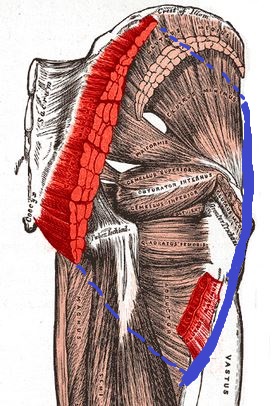
The fascia lata wraps around the entire leg. When muscles such as the gluteus maximus and tensor fascia lata contract, they “tense” the fascia lata which compresses the entire thigh region, which influences muscular contractile biomechanics. See THIS article – the fascia lata is more than just a stocking. In this manner, the gluteus maximus will influence the biomechanics of the entire leg musculature through myofascial force transmission.
Last year I showed you how the gluteus maximus greatly enhances knee stability during the lunge exercise HERE, through its influence on the tibia via the iliotibial band. The gluteus maximus has far-reaching influences across the body due to its fascial connections.
2. The deep sacral fibers of the gluteus maximus stabilize the sacroiliac joint
Having read THIS article on the deep sacral fibers of the gluteus maximus a couple of years ago, I was on the lookout to see this in the cadavers. The gluteus maximus contains short fibers deep into the muscle that cross the sacroiliac joint (SIJ) and most likely contribute to the stability of the structure (some fibers attach to the sacrotuberous ligament and can influence stability through this route too), thereby preventing low back pain. The SIJ appears to be implicated in approximately 25% of low back pain incidents according to THIS and THIS review, so this is quite important!
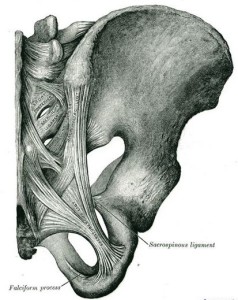
3. The gluteus maximus is well-built for hip external rotation
When you examine the fibers of the gluteus maximus, you can envision how they’d be well-suited for hip extension. However, it’s also quite apparent how effective their design is for hip external rotation. My EMG studies show that the gluteus maximus is HIGHLY recruited during band hip rotations and Pallof presses, and other research shows that the gluteus maximus is highly recruited in throwing, swinging, and striking actions in sports. To quote Professor Neumann in Kinesiology of the hip: a focus on muscular actions:
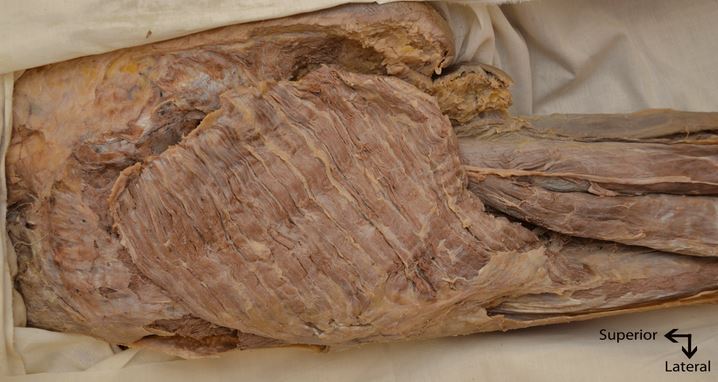
Basic trigonometry shows that 71% of the muscle force created by gluteal contraction can translate to external rotation torque! Here’s a good beginner movement for teaching the gluteus maximus of the rear leg to produce hip external rotation torque in order to counteract (stabilize) the hip internal rotation torque induced by the band.
4. The lower gluteus maximus fibers don’t adduct the hip; electromyography (EMG) trumps functional anatomy
I’ve seen dozens of textbooks and articles claiming that the lower fibers of the gluteus maximus produce hip adduction. For example, see HERE, HERE, HERE, HERE, and HERE.
When examining the fibers, it looks like the lower gluteus maximus fibers would indeed aid in adduction. Some of the fibers insert into fascia located near the medial side of the femur, which would make it seem that they’d be capable of producing adduction. However, herein lies the problem with just relying on functional anatomy for knowledge of biomechanics. In order to produce the movement, the lower fibers of the gluteus maximus would need to be activated during adduction movements.
In my experiments, I’ve been unable to detect any lower gluteus maximus activation in all the subjects I’ve tested during adduction maneuvers. Karlsson & Jonsson reported the same findings 48 years ago in 1965. To quote the authors,

Ain’t no gluteus maximus activity goin’ on here!
5. Gluteus maximus moment arms in the literature are highly underestimated
A moment arm is an measurement of a muscle’s leverage (in this case it would be deemed a muscle moment arm or an internal moment arm). This is important data in biomechanics, as it allows one to estimate a muscle’s torque capacity. To quote Channon et al.,
Check out the picture below. Look how close the glute max is going to be positioned to the hip in the saggital plane. This will yield a small moment arm measurement.
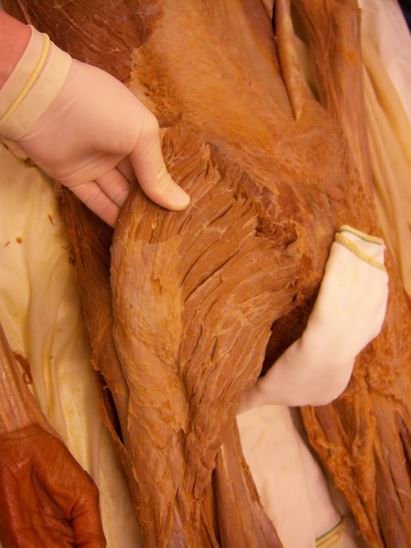
The gluteus maximus moment arm of an upright, athletic individual will be greater, and this will be even more pronounced when the gluteus maximus is contracting. Check out the picture below – the gluteus maximus moment arm is going to be markedly larger in this situation.

There is currently no research examining gluteus maximus torque capabilities in athletic subjects during athletic endeavors. For example, I bet that sprinters’ glutei maximi during sprinting or powerlifters’ glutei maximi during hip thrusting (or simply during MVC’s) would yield considerably greater gluteus maximus moment arm measurements, and the PCSA is affected too due to changes in pennation angle during muscle contractions.
If this is the case, and I’m pretty sure it is, then the strength and power potential of the gluteus maximus is underestimated in the literature. Sure you could say the same for other muscles, but I suspect that it’s underestimated to a greater degree in the gluteus maximus compared to other muscles.
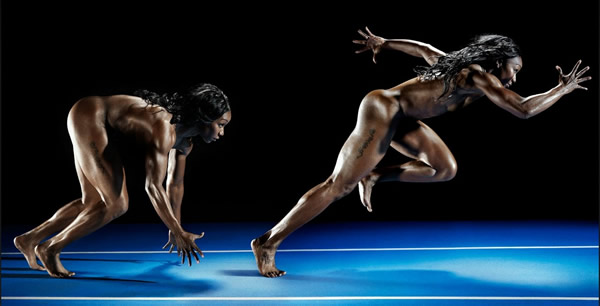
Carmelita Jeter, second fastest woman of all-time
6. Genetics Highly Influences Glute Size
The anatomy professor insisted that I inspect the smallest gluteus maximus specimen (belonging to a cadaver of a frail, elderly individual), as well as the largest gluteus maximus specimen (belonging to a middle-aged mammoth of a man). A few months ago I wrote about glute genetics HERE and reported that there is an inter-individual variation of 500% in terms of gluteus maximus volume, meaning that some folks have 5X the glute size of others. In inspecting the specimens, this became apparent. For the unlucky individuals with poor glute genetics, luckily they now have Strong Curves and Strong by Bret for some guidance and hope!

Last week I made an appointment with a PhD Anatomy professor to visit his laboratory and examine the muscular anatomy of cadavers. I’ve seen cadavers in the past, but now that I’m much more knowledgeable, I got much more out of the experience. Seeing the glutes in this state really allows you to envision their functional roles and capacities. Here are six glute facts that I’d like to share with you today:
1. The gluteus maximus does its thang through myofascial force transmission
Having actually felt the fiber insertions of multiple cadavers, this is what stood out to me the most. The vast majority of glute fibers insert into fascia. Textbooks say 70-85% but it might be even higher. Only a small percentage insert onto the gluteal tuberosity of the femur. See the pic below – the red insertion portion shows how much of the glute max inserts onto the leg – the rest (blue) inserts into the fascia lata (especially the iliotibal tract).

The fascia lata wraps around the entire leg. When muscles such as the gluteus maximus and tensor fascia lata contract, they “tense” the fascia lata which compresses the entire thigh region, which influences muscular contractile biomechanics. See THIS article – the fascia lata is more than just a stocking. In this manner, the gluteus maximus will influence the biomechanics of the entire leg musculature through myofascial force transmission.
Last year I showed you how the gluteus maximus greatly enhances knee stability during the lunge exercise HERE, through its influence on the tibia via the iliotibial band. The gluteus maximus has far-reaching influences across the body due to its fascial connections.
2. The deep sacral fibers of the gluteus maximus stabilize the sacroiliac joint
Having read THIS article on the deep sacral fibers of the gluteus maximus a couple of years ago, I was on the lookout to see this in the cadavers. The gluteus maximus contains short fibers deep into the muscle that cross the sacroiliac joint (SIJ) and most likely contribute to the stability of the structure (some fibers attach to the sacrotuberous ligament and can influence stability through this route too), thereby preventing low back pain. The SIJ appears to be implicated in approximately 25% of low back pain incidents according to THIS and THIS review, so this is quite important!

3. The gluteus maximus is well-built for hip external rotation
When you examine the fibers of the gluteus maximus, you can envision how they’d be well-suited for hip extension. However, it’s also quite apparent how effective their design is for hip external rotation. My EMG studies show that the gluteus maximus is HIGHLY recruited during band hip rotations and Pallof presses, and other research shows that the gluteus maximus is highly recruited in throwing, swinging, and striking actions in sports. To quote Professor Neumann in Kinesiology of the hip: a focus on muscular actions:
“The gluteus maximus is the most potent external rotator muscle of the hip. This suitably named muscle is the largest muscle of the hip, accounting for about 16% of the total cross-sectional area of all hip musulature. Assuming that the gluteus maximus muscle’s line of force is directed approximately 45° with respect to the frontal plane, maximal-effort activation would theoretically generate 71% of its total force within the horizontal plane (based on the sine or cosine of 45°). All of this force could theoretically be used to generate an external rotation torque.”

Basic trigonometry shows that 71% of the muscle force created by gluteal contraction can translate to external rotation torque! Here’s a good beginner movement for teaching the gluteus maximus of the rear leg to produce hip external rotation torque in order to counteract (stabilize) the hip internal rotation torque induced by the band.
4. The lower gluteus maximus fibers don’t adduct the hip; electromyography (EMG) trumps functional anatomy
I’ve seen dozens of textbooks and articles claiming that the lower fibers of the gluteus maximus produce hip adduction. For example, see HERE, HERE, HERE, HERE, and HERE.
When examining the fibers, it looks like the lower gluteus maximus fibers would indeed aid in adduction. Some of the fibers insert into fascia located near the medial side of the femur, which would make it seem that they’d be capable of producing adduction. However, herein lies the problem with just relying on functional anatomy for knowledge of biomechanics. In order to produce the movement, the lower fibers of the gluteus maximus would need to be activated during adduction movements.
In my experiments, I’ve been unable to detect any lower gluteus maximus activation in all the subjects I’ve tested during adduction maneuvers. Karlsson & Jonsson reported the same findings 48 years ago in 1965. To quote the authors,
So it appears that this misconception arose 58 years ago in some German textbook as a hypothesis via examining anatomy. But if theories don’t jive with experimental findings, then they need to be dropped.“Accordingly the results to not seem to bear out Kopsch’s (1955) hypothesis that the distal portion of the gluteus maximus can act as an adductor of the thigh.”

Ain’t no gluteus maximus activity goin’ on here!
5. Gluteus maximus moment arms in the literature are highly underestimated
A moment arm is an measurement of a muscle’s leverage (in this case it would be deemed a muscle moment arm or an internal moment arm). This is important data in biomechanics, as it allows one to estimate a muscle’s torque capacity. To quote Channon et al.,
When researchers measure the moment arms of muscles, they utilize different techniques. Sometimes they use cadavers, often of frail or older individuals (cadavers are dried up and flat). Sometimes they use CT scans, but the subjects are typically positioned supine which flattens out their glutes.“Muscles facilitate skeletal movement via the production of a torque or moment about a joint. The magnitude of the moment produced depends on both the force of muscular contraction and the size of the moment arm used to rotate the joint. Hence, larger muscle moment arms generate larger joint torques and forces at the point of application.”
Check out the picture below. Look how close the glute max is going to be positioned to the hip in the saggital plane. This will yield a small moment arm measurement.

The gluteus maximus moment arm of an upright, athletic individual will be greater, and this will be even more pronounced when the gluteus maximus is contracting. Check out the picture below – the gluteus maximus moment arm is going to be markedly larger in this situation.

There is currently no research examining gluteus maximus torque capabilities in athletic subjects during athletic endeavors. For example, I bet that sprinters’ glutei maximi during sprinting or powerlifters’ glutei maximi during hip thrusting (or simply during MVC’s) would yield considerably greater gluteus maximus moment arm measurements, and the PCSA is affected too due to changes in pennation angle during muscle contractions.
If this is the case, and I’m pretty sure it is, then the strength and power potential of the gluteus maximus is underestimated in the literature. Sure you could say the same for other muscles, but I suspect that it’s underestimated to a greater degree in the gluteus maximus compared to other muscles.

Carmelita Jeter, second fastest woman of all-time
6. Genetics Highly Influences Glute Size
The anatomy professor insisted that I inspect the smallest gluteus maximus specimen (belonging to a cadaver of a frail, elderly individual), as well as the largest gluteus maximus specimen (belonging to a middle-aged mammoth of a man). A few months ago I wrote about glute genetics HERE and reported that there is an inter-individual variation of 500% in terms of gluteus maximus volume, meaning that some folks have 5X the glute size of others. In inspecting the specimens, this became apparent. For the unlucky individuals with poor glute genetics, luckily they now have Strong Curves and Strong by Bret for some guidance and hope!


